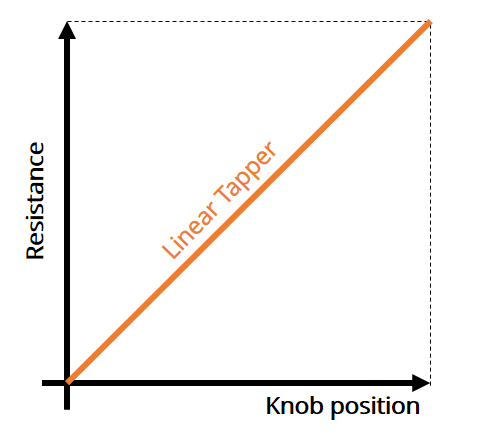
What is Potentiometer ?
Potentiometers are also called variable resistors or pot. They have three terminals, one terminal in the middle know as wiper, and the other two known as ends. The wiper is a movable contact where the resistance relative to it and one of the two terminals is measured.
They are useful for circuits that need to dynamically change resistance to control current. They are also very popular as voltage dividers.
Potentiometer Taper
A main concept related to potentiometers is taper. Taper is the relationship between the position of the potentiometer and the resistance. The most common types are linear taper and log logarithmic taper.
Linear potentiometer
The most common form is simple linear taper. In linear taper, the relationship between resistance and potentiometer position is linear.
This means that if the potentiometer knob is in the middle position, the output voltage is half of the potentiometer voltage. See the picture below.

Logarithmic potentiometer
Non-linear tapers are mainly used for audio control applications, namely logarithmic tapers (also inverse-logarithmic tapers). The relationship between position and resistance is shown below:

How does a potentiometer work?
Potentiometers work by having a resistive element inside. Both end terminals are attached to it, and do not move. The wiper travels along the strip when the knob is turned. The closer the wiper is to the end terminal it is wired in conjunction with, the less the resistance, because the path of the current will be shorter. The further away it moves from the terminal, the greater the resistance will be.
The symbol for a potentiometer is the same one as a resistor, save for an arrow in the middle. In a circuit where they are used strictly as variable resistors or rheostats, only two terminals are wired to the other components. All three terminals are wired Separately when they function as voltage dividers. Light dimmers in houses and volume controls on electronics are two common applications. Others include switches and position sensors.
How to remove a potentiometer from PCB board ?
To salvage potentiometer from a PCB requires the proper tools and some skill, because to melt the solder joints you need heat, well heat will rapidly damage potentiometer beyond any further use.
You do need a soldering iron, plus some desoldering aids like a copper wicking braid and a solder sucker. This will allow you to quickly remove the majority of the solder from each pin. The potentiometer will most likely still be held fairly firmly in the board by residual solder, especially if the board is a through-hole plated type.
The next step is to use a heat gun to remelt all the residual solder at once while applying force to the part to pull it out. You have to be quick – do not let the heat linger on the board too long because it will damage the potentiometer quite quickly, it has plastic parts in them and these will readily melt if they get hot enough. If the part doesn’t come free in a few seconds, let it cool down before trying again.
If you need to remove & replace the potentiometer, you also have to take care not to damage the PCB itself. These will also not withstand a lot of heat for very long before the board starts to burn and the tracks separate.
If it’s still not easy for you, then find a friendly electronics hobbyist who will do it for you.
If you are looking for supplier of Potentiometer PCB, please feel free to contact us.